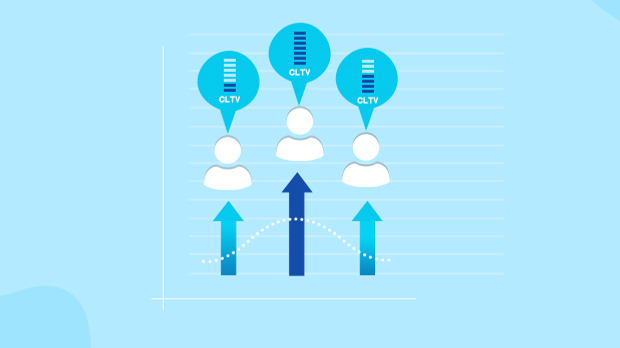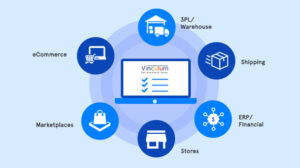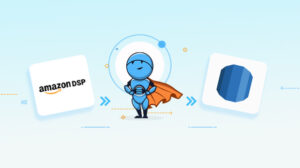Do you know 76% of companies take Customer Lifetime Value as a crucial part of their business? If your business is not a part of this 76%, you are not considering the CLV as your tool to gain customers and let go of profits. Studies reveal that it is 5x – 25x expensive to acquire a new customer as compared to retaining the old one. For this reason, many small and big business owners spend time and resources to retain their existing customers. One of the best ways to retain your customers and avoid scrambling for new business is by measuring the Customer Lifetime Value. When you calculate the CLV, it helps you to retain valuable customers and generate more revenue over time. Keep reading to learn more about improving your business with CLV.
What is a Customer Lifetime Value
Customer Lifetime Value (or CLV) is the total worth of a single customer to the business throughout their business relationship. However, many confuse CLV with CSAT or NPS (Net Promoter Score), which measures customer satisfaction and loyalty rates. Calculating the CLV will help business owners allocate their resources, time, and effort in the right direction. For instance, a business owner will understand how much he needs to spend to acquire and/or retain new customers.
Calculating CLV helps you to know the probability of the customer spending money on buying your services or products. Furthermore, it reveals how much a customer can spend on the company in his entire lifetime. As a business owner, spending your resources wisely while targeting customers is vital. The customer lifetime value will help you to analyze the customer segments that contribute more to your business. This, in turn, will ensure you get the maximum benefit from your resources.
What are the methods of predicting Customer Lifetime Value
There are two simple methods by which you can determine the customer’s lifetime value. These include:
Historical method
The historical method to determine CLV is based on the experience of your business with a particular customer. That is why this model evaluates customer value through past data. The average order value is used to determine if the customer will keep on doing business with your company in the future. However, one thing to remember in the case of historical models is that the model is not efficient enough to predict customer pattern changes. For example, the model will not work accurately if an inactive customer starts buying your products or suddenly, an active customer stops buying.
Predictive method
The predictive method is used to evaluate the future buying habits of existing customers. The model’s evaluation is based on how much a customer can spend in the future. Therefore, when a company uses the model, they can easily find out the products and customers that are more valuable. However, predictive models are a little more complicated than historical models, but you can rely on the accurate results it offers.
Due to fluctuations in customer interest in products and services, it is vital to have in-depth knowledge about the customer’s lifetime value. Though both methods work to predict the value of a customer, it is crucial to choose the method wisely. First, you need to understand your business needs and preferences and then select the method that serves you with the best results.
Simple way to calculate Customer Lifetime Value
Analyzing the customer lifetime value of the financial project is one of the best ways to make informed decisions. Calculation of CLV can help you understand which customer segment is more profitable than others and which customer is worth targeting. If you are looking to calculate the CLV, you must multiply customer value and average customer lifespan. The result you get after multiplication will directly contribute to the CLV.
Let us look at the simple formula. Then, you can easily calculate the customer’s lifetime value.
To calculate the customer lifetime value, you need to use two metrics:
- Customer value, and
- Average customer lifespan.
Formula to calculate CLV
Customer Lifetime Value = Customer Value x Average Customer Lifespan
Where,
- Average Order Value = Total Sales / Order Count
- Purchase Frequency = Total Orders / Total Customers
- Customer Value = Average Order Value x Purchase Frequency
- Average Customer Lifespan = Average Number of Days between the first and the last order of a customer.
This will help you to get proper knowledge about how valuable a particular customer or customer segment is for your business.
Calculating Customer Lifetime Value using MS Excel
Calculating CLV using MS Excel is simple. Here are two approaches you can use.
Method 1:
CLV = Frequency x time x gross margin
Where,
- Frequency of customer purchases,
- An estimated period when he is expected to be loyal to a Brand,
- Gross margin = Net Sales Revenue – Cost of Goods.
Method 2:
CLTV = Cumulative Net Present Value / New Customers Gained
Where,
- Acquisition Cost per Customer = Total marketing costs across all channels / Number of new customers gained.
- Average Orders Per Year = Number of orders serviced / Number of new customers gained
- Average Order Size = Total revenue generated in a particular year / Number of orders serviced
- Total Cost = Total marketing costs across all channels + Cost of Goods
- Gross Profit = Total revenue generated in a particular year – Total Cost
- Assuming a Discount Rate that is a standard in the specific industry, we arrive at Discount Rate.
- Net Present Value = Discount Rate x Gross Profit
- Cumulative Net Present Value = Net Present Value 1 + Net Present Value 2 + Net Present Value 3
| Values | Year 1: Acquisition | Year 2 | Year 3 |
| Total Revenue | $2,700,000 | $1,562,500 | $1,203,125 |
| Marketing Costs | $120,000 | $5,000 | $5,000 |
| Customers | 10,000 | 2,500 | 1,750 |
| Retention Rate | 25% | 70% | 80% |
| Acquisition Cost | $12 | $0 | $0 |
| Orders Per Year | 1.2 | 2.5 | 2.5 |
| Average Order Size | $225 | $250 | $275 |
| Cost Of Goods | $1,890,000 | $1,093,750 | $842,188 |
| Total Costs | $2,010,000 | $1,098,750 | $847,188 |
| Gross Profit | $690,000 | $463,750 | $355,938 |
| Discount Rate | 1.00 | 1.08 | 1.16 |
| Net Present Value | $690,000 | $429,398 | $306,843 |
| Cumulative NPV Profit | $690,000 | $1,119,398 | $1,426,241 |
| CLV | $69.00 | $111.94 | $142.62 |
A company may sell its products and services in multiple countries via eCommerce platforms. Each country has different marketing platforms, payment gateways, inventories, logistic channels, and target audiences. Hence, businesses are bound to use several tools and applications for each job.
Profits/Losses = Sales – Expenses
The sales data will come from eCommerce sites for a simple profit calculation. To calculate Expenses, you need to factor in
- Marketing costs coming from platforms like Google AdWords, Facebook Ads, etc.,
- Purchasing stock which might come from inventory management platforms like Olabi,
- All other expenses occurred from accounting software like FreshBooks.
And there will be different data silos for each country. Thus, you must pull all these data from multiple platforms for each country separately in excel. Then, analyze all this data with the expense data and calculate profits. It involves a lot of working hours which cost money, and there is usually a time lag involved, which reduces the accuracy of the analysis and its effectiveness as the data is not analyzed in real-time. Thus, it becomes necessary to consolidate all the data in a data warehouse. Daton is fully managed, eCommerce-focused data pipeline that seamlessly extracts relevant data from many data sources for consolidation into a data warehouse of your choice for more effective analysis.
Calculating Customer Lifetime Value using Google Analytics
To calculate the CLV in Google Analytics, you need to-
- Sign into your Google Analytics account
- Click on Audience
- Get the Lifetime Value Report
Google Analytics will determine lifetime values for people acquired through different channels and mediums, like social, email, and paid search. In addition, there will be data by page views, goals, events, and trends after customer acquisition. As a result, it will be easier to identify the sources driving the most valuable traffic and corresponding marketing investments that truly deliver good ROI (return on investment). Hence, this Lifetime Value report facilitates business owners to acquire data to understand how helpful certain users and customers are to their businesses based on their lifetime performance.
Why is Customer Lifetime Value important for your business growth
In short, yes. As it determines the value of the customers associated with your business, CLV plays a significant role in business growth. CLV will help you analyze which products you should sell, how you should serve your customers, and how you can optimize your business. Analyzing these conditions will help you improve the customer lifecycle with your business and the bottom line of your business. It allows you to double your sales, increase profits and boost the return on investment. Still on the fence about why you need to measure CLV for your business?
Impacts your Profitability
Measuring CLV can directly impact the profitability of your business. This is so because acquiring new customers is more expensive than retaining the existing ones. When you acquire a new customer, you need to pay the cost of the acquisition every time. This, in turn, lowers your profit and reduces the sale margin. On the contrary, when an existing customer buys your product, you do not have to pay for anything. Thus, your business will get the entire profit from the sale, which contributes to high ROI.
Keeps your Cash Flow Steady
Another important reason for CLV is that your business will get a steady cash flow. No matter the circumstances, your loyal customers will shop from your business. Knowing that a part of the money will come into your business helps you cover up your due payments and maintain a steady cash flow.
Boost Customer Loyalty
CLV is one of the most important ways to keep your customer happy and satisfied. This is because CLV helps the business owner to understand the customer journey and improve it to retain customers. When you know where your potential customers are churning, it helps you to optimize and personalize the experience given to them. When you let your customers enjoy shopping with your business, they will come back.
Effective Marketing Strategies
Business owners can use CLV as their segmentation strategy. The analysis of CLV helps you to identify the customers that bring profit to your business. Once you understand the business value that each potential prospect brings, it assists you in personalizing customers’ experience and improving resource usage. With CLV, you will get an idea about how to use different strategies to turn your low-level and mid-level customers into long-term loyal people.
As per the study by Signal mind, the profitability of the sales made by a new customer is around 5-20%. On the other hand, the profit is 60-70% when an existing customer shops for your products. This drastic difference in profitability proves the total value of CLV for your business. When you retain customers with the help of marketing strategies, tailor-made solutions, and personalized customer service, the advantage directly shows up in your business’s bottom line. So, regardless of whether you are a small-scale business or own a large enterprise, calculate customer lifetime value to improve your business.
How do different teams find Customer Lifetime Value useful?
Calculating and monitoring customer lifetime value is essential for every business. It helps to identify high-value customers for companies to focus on and enhance revenue coming from these customers by providing them with facilities like better deals, offers, and better customer support to increase their sales further. Let us see how teams in a company find CLV helpful:
Administration
CLV comes into play while calculating future projections when a business is considering expansion. A Healthy CLV indicates a decent assured company and better ROIs (return on investment), indicating the best time to expand sustainably, helping the CXOs take the right call.
Marketing
The goal of determining lifetime value for any marketer is to ensure that the marketing campaigns are profitable. CLV indicates probable ROIs of a marketing campaign. It helps Marketers optimize budgets in each campaign and clarifies how much to invest in which customer segment.
For instance, a marketing manager is planning a paid campaign on Google. She estimates the number of clicks the ad will generate within a particular timeframe based on keyword trends. She also has an idea estimates the bounce rates on her landing page and the number of leads generated from those clicks. This will help her clarify the number of customers she can expect from this Google Campaign. Now using CLV, she can get a projection of the expected revenue/profits that will be generated from this campaign, enabling her to easily calculate ROI, optimize her budgets accordingly, and set benchmarks for each campaign.
Production
CLV calculations are essential to the production team as well. For example, a Dropping CLV trend after a change in production materials might indicate a quality issue. But, again, businesses can do cost-cutting and improve margins if CLV is unaffected.
Logistics
The shipping team can evaluate the efficiency of each shipping partner by the CLV of their serviced customers. CLV can decrease due to
- Delayed product delivery,
- Damaged products,
- Poor packaging,
- Poor return policy,
- Lack of proper shipment tracking.
Sales
Understanding a Customer’s CLV is an essential insight for Sales Teams. The sales pitch would be different for a high-valued client.
For example, a sales manager would look to include many value-added services to clients with high CLV to maximize their revenue. While with clients with lower CLV, the sales pitch would be more in tune with retaining the customer and offering them offers and discounts.
Customer Support
CLV is the most important for customer support teams. Since CLV increases with returning customers, that happens when customers are satisfied. CLV can measure Customer Support Efficiency and help identify high-value clients so businesses can provide more focused and prioritized support. For example, a customer support manager can look at the CLV trends of customers serviced by an executive to judge their efficiency. He can identify High-Value Clients & allocate the best executives to handle them.
Tactics to grow the Customer Lifetime Value
Understanding the value of your customers and how much they bring to your business is essential to choosing the ways that offer the right results. Having a high CLV means each existing business customer is helping you improve your sales and marketing efforts. When each customer is valuable, your marketing team can devise effective strategies that bring more value to your business. Unfortunately, even though having a high CLV rate is important, many businesses find it hard to improve CLV. If you are looking to boost the CLV and improve your business, you must follow a few strategies. These include:
Conduct Surveys & Questions
When it comes to serving customers better, you need to start by identifying your customers’ pain points. Then, you need to understand what can improve your product/service to attract or retain existing clients. One of the best ways to improve the ratings of CLV is by conducting surveys and asking questions from your customers about the products or services of your company. When you collect voice of customer data, it helps you to improve your service and ensure that your business gets recurring customers.
Boost Customer Service
32% of the customers will not continue their business with the same company if they incur a terrible experience, says PwC study. For this reason, you need to retain your customers by improving the customer service you offer them. One of the best ways to boost customer service is by investing in multichannel or omnichannel customer support. When there are different ways to connect with your business, it helps customers from broad demographics to contact you. This, in turn, will lead to improved customer service and customer success.
Invest in Customer Loyalty Program
Investing in customer loyalty programs is vital to improving customers’ loyalty to your business. For example, you can offer discounts on the products and services that customers often buy. Moreover, you can offer member-only promotions that will insist customers be your member to leverage the benefits of promotional offers. When you offer something extra and valuable to your customers, they remain with your business for a long time.
Engaging and Valuable Content
Offering valuable and informative content is essential for your business. It is important to help keep your customers engaged with your business. Emails, blog posts, emails, etc., are a few ways by which you can share valuable information with your customers. Nowadays, people spend more time on social media platforms, so be sure not to miss offering valuable content to customers to build a trustworthy and credible business website. Be sure you highlight the abilities of your employees and your products through the content without sounding sales oriented.
Cross-sell and Upsell
Cross-selling and up-selling are the two most essential methods to retain customers. A business that offers additional services and add-on services builds customer loyalty and reduces cart abandonment. Moreover, customers will appreciate personalized services when you provide relevant products and services. This, in turn, will help you to keep bringing back your existing customers and boosting your sales.
Without customers, driving your business towards growth would be nearly impossible. Utilizing the above strategies will help you improve how your customers interact and ensure that they get a solid reason to come back and shop. Though there is extreme competition in the market, it depends on how far you wish to take your business.
Conclusion
If you are a business owner looking to get business insight to improve profitability, you must focus on calculating customer lifetime value. Business owners who wish to scale their business in the hyper-competitive world should consider CLV while mapping out the marketing strategy. Having the necessary knowledge about your products and customers can help you outrank your rivals and stay ahead by retaining customers. The sooner you understand the benefits of CLV for your business, the better it will be to hedge against the competition.
For calculating the CLV, you need access to many reports and information. Extracting the information and getting the reports done manually is a time-consuming process prone to human error. That is where we, Saras Analytics, can help with us eCommerce-focused Data pipeline – Daton and custom ML (Machine Learning) and AI solutions to ensure you always have the correct data at the right time. Request a demo and envision how reporting is supercharged with a 360° view.













